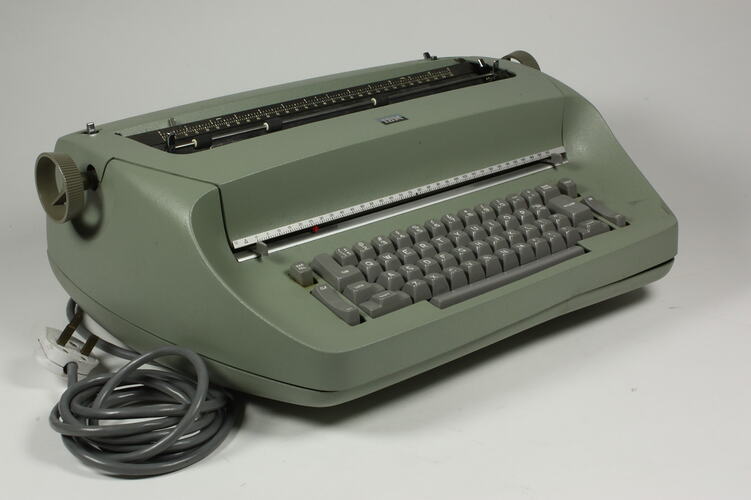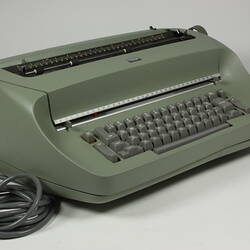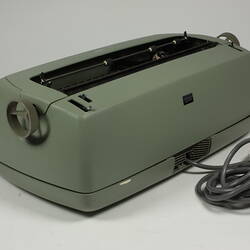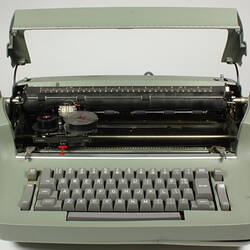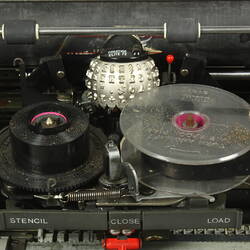Summary
Electric typewriter manufactured by the International Business Machines Corporation (IBM) in the United States. This machine incorporated an almost spherical type wheel which became known as the 'Golf Ball'. In earlier typewriters the platen and paper moved horizontally past a fixed printing point. In the IBM machine the paper and platen are fixed. The Golf Ball moves horizontally to shift the printing point across the paper, while at the same time rotating to bring the desired character embossed on the Golf Ball surface to the printing point.
Physical Description
Greenish-grey enamelled metal case. 13 inch (330 mm) cylindrical platen. Spherical type wheel of the 'Golf Ball' design. Four-row QWERTY keyboard with 44 character keys and ten control keys. Complete with flexible plastic cover, desk mat, several typewheels with alternative fonts, spare ribbons, and operating instructions.
Significance
This golf ball typewriter was used by Kingsley Carr for personal activities. He purchased it around early to mid 1970s but he cannot remember the cost. He hardly used it but when he did it was for personal typing at home. Kingsley kept the typewriter in good condition and retained its manual and cover (also offered for donation). He also kept a range of golf balls of different fonts, and a collection of spare ribbons.
Kingsley's golf ball typewriter is significant as a typical example of typewriter technology used in the later 20th century. The preservation of associated accessories makes this example of particular interest. The Selectric I electric typewriter was introduced by IBM in 1961. It is regarded as revolutionary. It replaced the standard typebars with a moving interchangeable spherical "golf ball" printing element. The carriage remained fixed. Development began in 1951, and the sculptured housing was designed by Eliot Noyes who started work in 1959. In 1971, a later version, Selectric II, entered the market. By 1975 Selectrics accounted for about 75 percent of the US electric typewriter market. The market collapsed when typewriters were increasingly replaced by personal computers.
According to the IBM Products Division press fact sheet published in August 1976, "[The typewriter] prints by means of a single, interchangeable sphere-shaped typing element bearing 88 alphabetic characters, numerals and punctuation symbols. It has no typebars and no movable carriage. The printing element is mounted on a small carrier which runs along a cylindrical metal bar while typing. Because the writing element moves, and not the paper-carrying unit, the need for a conventional carriage is eliminated. For this reason, the "Selectric" typewriter requires less space, vibration is minimized, and there is no carriage return jolt. Another important feature of the new machine is the ability to change type styles in seconds through the single element typing principle." (http://www-03.ibm.com/ibm/history/exhibits/modelb/modelb_office.html accessed on 4 February 2005).
The golf ball mechanism, when introduced in 1961, marked the first revolutionary change in typewriters since they were first developed commercially. It also marks the beginning of what was later known as desktop publishing but using typewriters.
More Information
-
Collecting Areas
-
Acquisition Information
Donation from Mr. Kingsley Carr, 18 Feb 2005
-
Manufacturer
International Business Machines (IBM), New York, United States of America, circa 1967
-
Inscriptions
On centre top of case, in front of platen: 'IBM' On centre back of case: 'IBM' On label beneath centre rear of machine: 'IBM AUSTRALIA LIMITED / RECONDITIONED FOR RESALE / DATE INSTALLED _______ / TYPESTYLE _______/ S/No. ________' On plastic cover and on desk mat: 'IBM'
-
Classification
-
Category
-
Discipline
-
Type of item
-
Overall Dimensions
542 mm (Width), 395 mm (Depth), 180 mm (Height)
Dimensions of typewriter only.
-
Keywords
